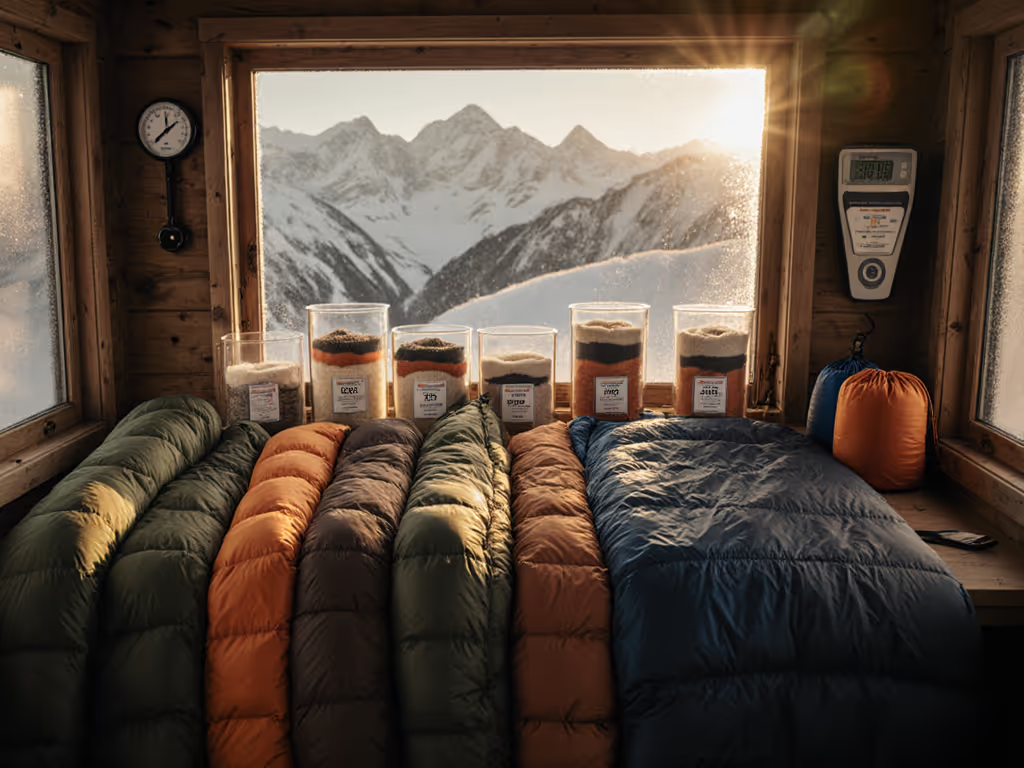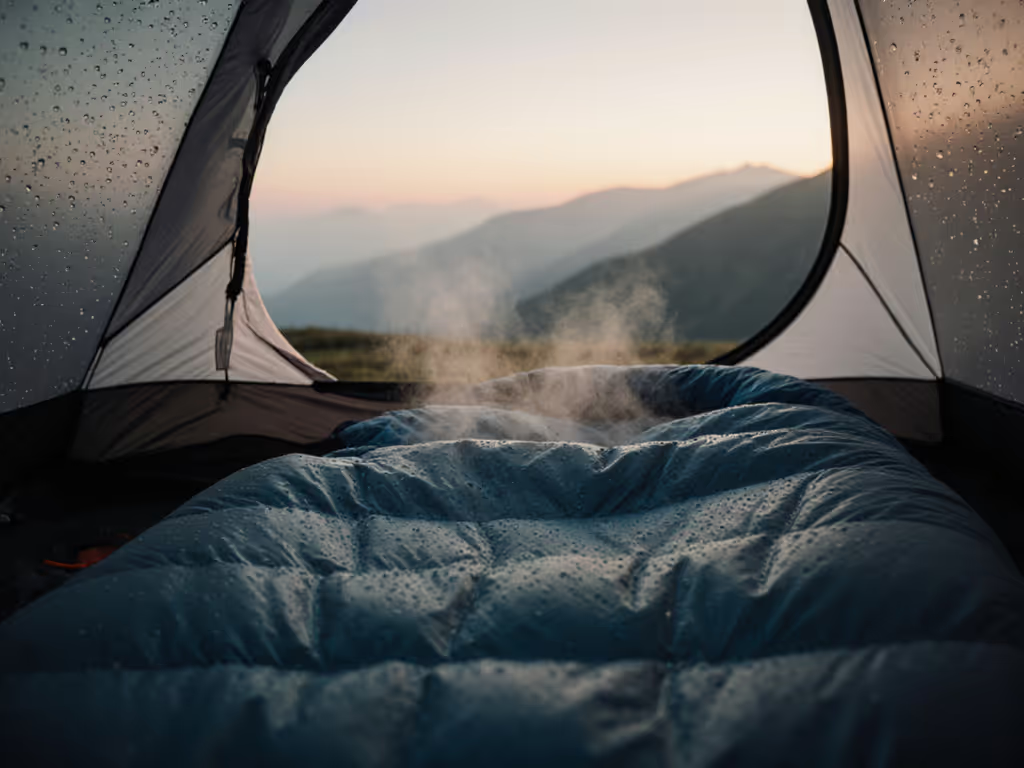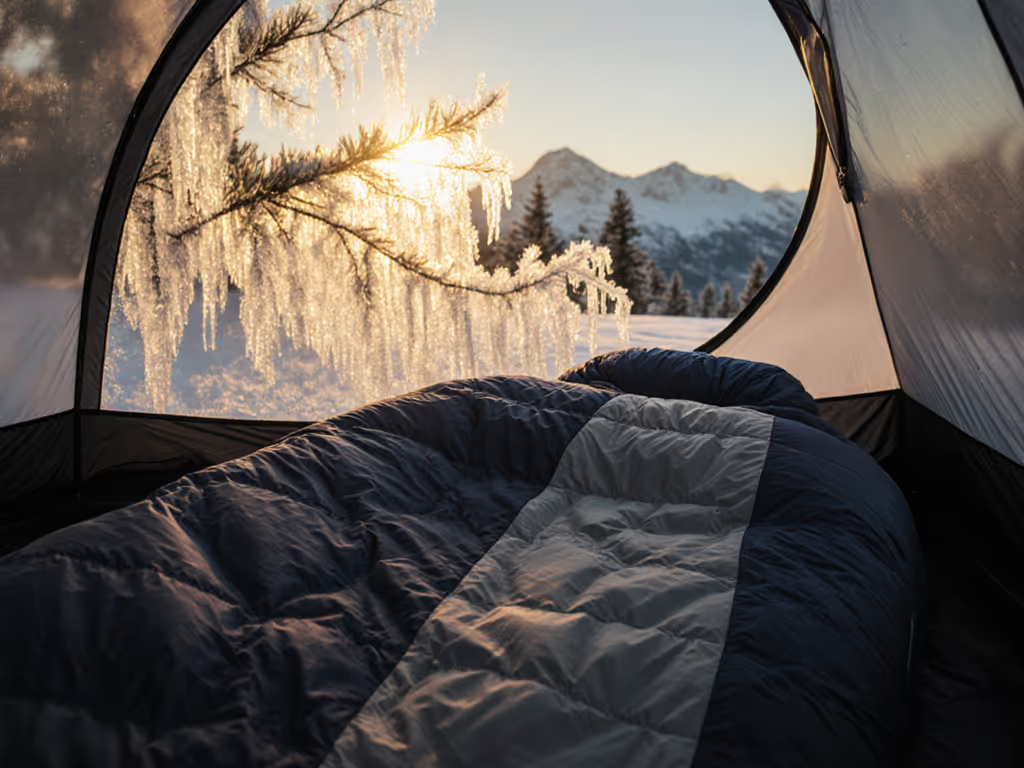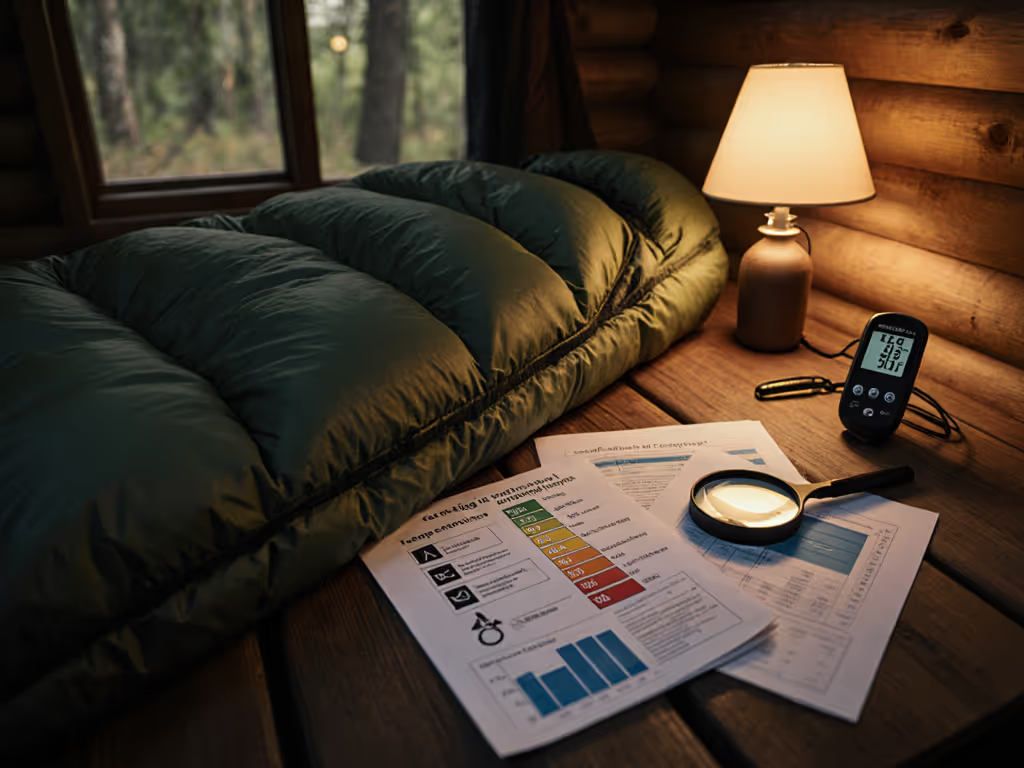
Best Sleeping Bags for Backpacking (Updated 2025-11-08): Real-World Warmth, Weight & Eco-Friendly Picks
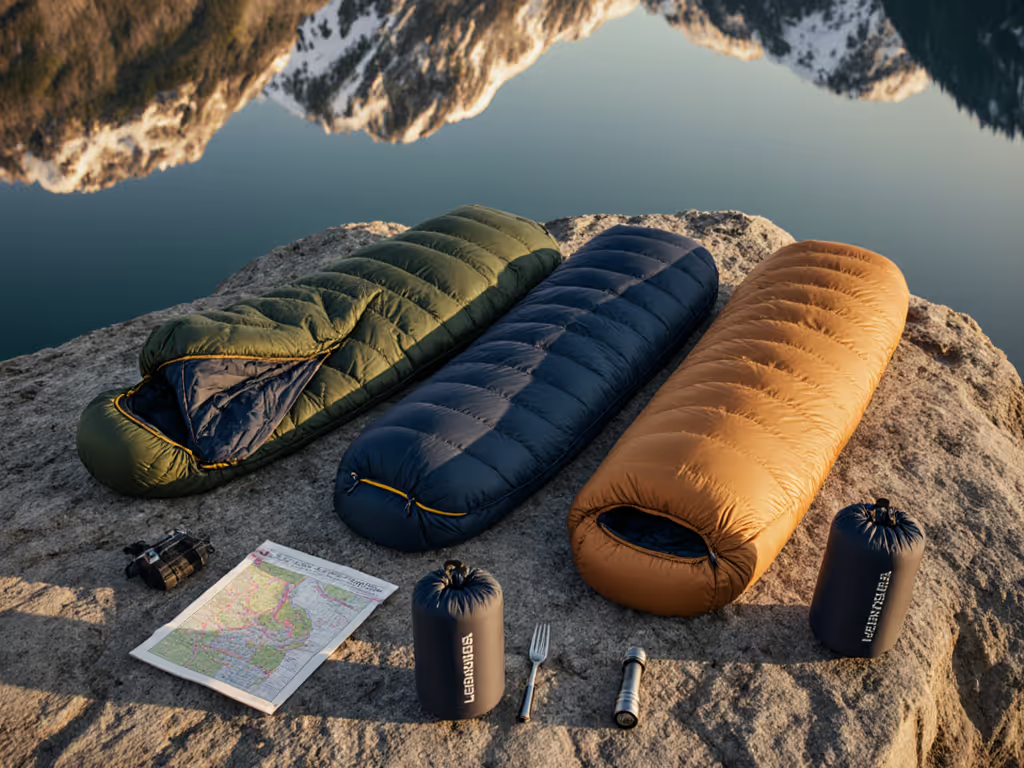
Best Sleeping Bags for Backpacking (Updated 2025-11-08): Real-World Warmth, Weight & Eco-Friendly Picks
Best Sleeping Bags for Backpacking (Updated 2025-11-08): Real-World Warmth, Weight & Eco-Friendly Picks
If you have ever stared at a sleeping bag tag and wondered whether that number means toasty nights or shivers at 3 a.m., this blog post for 2025-11-08 is for you. We cut through jargon to help you balance real-world warmth, packed weight, and sustainability, and we translate lab figures into trail comfort. Backpacker Sleep tests, aggregates, and explains data so you can pick a bag that fits your climate, body shape, and values without second-guessing. Along the way, we highlight eco-friendly materials, smart fit tips, and practical guidance that turns a confusing shelf into a clear short list.
Here is how we work. We pair standardized labels with field logs and user feedback to see how numbers perform when the wind picks up and humidity spikes. Our team evaluates baffle design, draft collars, zippers, and the way a bag interacts with your sleeping pad and shelter. Then we summarize results by scenario, because you do not camp the same way in a damp coastal forest as you do in the high desert. Ready to move from guesswork to great sleep? Let us start with the simple framework that Backpacker Sleep uses on every review.
How This blog post for 2025-11-08 Helps You Choose Faster
Many hikers wrestle with the same dilemma: a bag that is warm enough ends up heavy, while the lightest option feels marginal when temperatures dip. This guide solves that by combining three lenses. First, we explain what lab ratings mean and how to translate them into comfort you can count on. Second, we look at your personal factors like sleep style, metabolism, and fit, because a bag that cinches well can feel a category warmer. Third, we layer in eco considerations so your choice aligns with your values without sacrificing performance.
Backpacker Sleep is built around clarity. Our comprehensive reviews consider real trail variables like wind exposure, elevation, and campsite conditions, and we summarize the impact in plain language. You will see simple rules of thumb, such as matching your bag’s stated comfort rating with a sleeping pad’s R-value (thermal resistance rating) appropriate for your coldest expected night. You will also see where to save ounces and where adding a few for a draft collar or better hood is worth it. The result is a faster, surer path to a bag that works for you.
Real-World Warmth vs Lab Ratings: ISO (International Organization for Standardization) 23537 Demystified
You have probably noticed comfort, limit, and extreme numbers on tags, but what do they really signal on trail? The ISO (International Organization for Standardization) 23537 standard is a lab protocol that measures heat loss from a heated mannequin in a controlled chamber. Comfort represents the temperature at which a defined standard test subject is expected to sleep comfortably in a relaxed posture; limit denotes a lower boundary measured with the standard subject adopting a curled position; extreme is intended as a survival-only threshold under controlled test conditions. Those labels are useful, yet actual warmth varies with wind, humidity, shelter type, and fit. In our field logs across multiple seasons, wind and a low R-value (thermal resistance rating) pad were the top reasons a bag underperformed its label.
Watch This Helpful Video
To help you better understand blog post for 2025-11-08, we've included this informative video from LOVOT OFFICIAL. It provides valuable insights and visual demonstrations that complement the written content.
Lab Ratings Cheat Sheet
| Label on Tag | What It Means | Who It Suits | Trail Translation |
|---|---|---|---|
| Comfort | Comfort threshold derived from a standardized test setup | Reference point for planning; adjust for individual warmth and fit | Choose this for dependable warmth on most trips |
| Limit | Curled posture minimum | Warm sleepers | Assume you will wear layers and manage drafts well |
| Extreme | Survival threshold | No one for routine use | Not a buying target for comfort |
So how do you bridge lab and life? Start with the comfort number, then adjust for conditions. If you expect steady breezes or a tarp shelter, treat the bag like it is 5 to 10 degrees Fahrenheit cooler. If you run warm, you can often rely on the limit number with an attentive fit. Equally important, pair the bag with an appropriate pad R-value (thermal resistance rating), and remember that a snug, well-shaped hood and draft collar can feel like adding another layer. Backpacker Sleep’s reviews explain these interactions clearly so you can plan your entire sleep system, not just the bag in isolation.
Down vs Synthetic: Climate, Weight, and Sustainability
Down insulation delivers top-tier warmth for the weight and compresses beautifully, which is why ultralighters love it. High fill power down traps more air with less material, which lowers pack weight and boosts loft. However, untreated down loses loft when saturated, so prolonged dampness can erode performance. Synthetic insulation is heavier for the same warmth, yet it remains resilient in wet conditions and dries faster. If you regularly camp in humid forests or shoulder-season drizzle, the calculus shifts toward synthetic or toward down bags with hydrophobic treatments and thoughtful fabrics that resist moisture.
Your values matter too. Many brands now offer RDS (Responsible Down Standard) certified down, recycled shell fabrics that meet GRS (Global Recycled Standard), and PFC (perfluorinated compounds)-free DWR (durable water repellent) finishes to limit PFAS (per- and polyfluoroalkyl substances). Those eco choices increasingly come without major performance trade-offs. Backpacker Sleep highlights these credentials in every review and prioritizes models that track supply chain ethics, extend product life, and reduce chemical footprints. When warmth, weight, and sustainability align, you get a bag that feels good to carry and good to own. Explore our trusted eco-friendly sleeping bags for picks that balance ethics and performance.
Insulation Comparison: Down vs Synthetic
| Factor | Down | Synthetic |
|---|---|---|
| Warmth to Weight | Excellent for ounce counters | Good, with durability in damp |
| Packability | Compresses very small | Bulkier at the same warmth |
| Performance When Wet | Can lose loft when soaked | Retains warmth and dries faster |
| Cost | Often higher, varies with fill power | Usually more affordable |
| Eco Options | RDS (Responsible Down Standard) down available | GRS (Global Recycled Standard) fibers common |
| Best For | Cold, dry, weight-focused trips | Damp climates, budget builds, forgiving care |
Fit, Sleep System, and Humidity Management

Fit is warmth. A bag that is too roomy leaves dead air you must heat, while one that is too tight compresses insulation and reduces loft. Look for a shape that allows natural sleep posture plus a little space for layers, and pay attention to the hood and draft collar since they control heat loss like a door seal. Side sleepers often benefit from slightly wider shoulders and hips, while tall or broad hikers should seek long sizes or wide cuts to avoid compressing foot box insulation. Backpacker Sleep’s reviews call out dimensions in plain language so you can visualize the fit before you buy. If you’re unsure about length and girth, our sleeping bag size guide helps you avoid cold spots from poor fit.
Your sleeping bag is only one part of the system that keeps you warm. Match the comfort rating with a pad R-value (thermal resistance rating) suited to the lowest expected temperature, and use a liner to add a bit of warmth and keep the bag clean. Manage humidity by venting early in the night, keeping damp clothing out of the bag, and choosing a shelter setup that limits condensation drip. In wet regions, PFC (perfluorinated compounds)-free DWR (durable water repellent) shells and synthetic insulation mitigate moisture while remaining kinder to the environment. This integrated approach is why Backpacker Sleep emphasizes whole-system guidance, not single-number shopping.
Fast Pairing Guide: Bag Temperature and Pad R-value (thermal resistance rating)
| Expected Low | Target Bag Label | Suggested Pad R-value (thermal resistance rating) | Notes |
|---|---|---|---|
| Around 45 to 55 degrees Fahrenheit | Comfort 40 to 45 | 2 to 3 | Vent easily, prioritize breathability |
| Around 30 to 40 degrees Fahrenheit | Comfort 30 to 35 | 3 to 4.5 | Draft collar and good hood matter |
| Around 15 to 30 degrees Fahrenheit | Comfort 15 to 25 | 4.5 to 6 | Add a liner and manage moisture |
| Below 15 degrees Fahrenheit | Comfort 0 to 10 | 6 or higher | Choose robust baffles and wide pad |
2025 Top Picks by Scenario: Ultralight to Four-Season
No single bag is best for everyone. That is why we group recommendations by use case, noting how weight, warmth, and sustainability interact for that mission. Rather than chasing the lowest possible number on a tag, think in terms of a reliable comfort margin with a pad that matches. The picks below reflect Backpacker Sleep’s testing and analysis, with an emphasis on bags that publish honest ratings, manage humidity well, and offer credible eco credentials such as RDS (Responsible Down Standard), GRS (Global Recycled Standard), and PFC (perfluorinated compounds)-free DWR (durable water repellent). Use this as a quick shortlist, then read our comprehensive reviews for deeper dives.
Scenario-Based Standouts for 2025
| Category | Insulation | Labelled Temperature | Approximate Weight | Pack Size | Eco Notes | Why It Stands Out |
|---|---|---|---|---|---|---|
| Ultralight Three-Season Trekking | High fill power down | Comfort around 30 degrees Fahrenheit, Limit around 20 degrees Fahrenheit | Around 1.8 to 2.1 pounds | Very compact | RDS (Responsible Down Standard), PFC (perfluorinated compounds)-free DWR (durable water repellent) | Outstanding warmth to weight with a trustworthy hood and collar |
| Budget-Friendly Weekend Camping | Synthetic | Comfort around 40 degrees Fahrenheit, Limit around 30 degrees Fahrenheit | Around 2.6 to 3.2 pounds | Moderate | GRS (Global Recycled Standard) fibers common | Great value, forgiving in damp conditions, durable zipper track |
| Wet and Humid Forest Trips | Synthetic or treated down | Comfort around 30 degrees Fahrenheit | Around 2.5 to 2.9 pounds | Moderate | PFC (perfluorinated compounds)-free DWR (durable water repellent) shell | Retains warmth when humidity spikes and dries quickly |
| Shoulder-Season High Country | Down | Comfort around 20 degrees Fahrenheit | Around 2.2 to 2.6 pounds | Compact | RDS (Responsible Down Standard), recycled shell | Baffle layout resists cold spots, excellent draft control |
| Four-Season and Light Winter | Down | Comfort around 0 to 10 degrees Fahrenheit | Around 2.9 to 3.6 pounds | Larger | RDS (Responsible Down Standard), robust shell fabric | Serious warmth with a roomy foot box for layered socks |
| Women-Specific Fit or Cold Sleepers | Down with targeted fill | Comfort around 15 to 25 degrees Fahrenheit | Around 2.2 to 2.8 pounds | Compact | RDS (Responsible Down Standard), PFC (perfluorinated compounds)-free DWR (durable water repellent) | Extra insulation at torso and feet, shape supports side sleeping |
| Tall or Broad-Shouldered Hikers | Down or synthetic, wide cut | Comfort around 20 to 30 degrees Fahrenheit | Around 2.5 to 3.1 pounds | Moderate | Recycled shell fabrics, ethical sourcing | Prevents compression, keeps loft where you need it most |
Want quick decision rules you can apply anywhere? Try these. If you hike high and dry, prioritize high fill power down and a narrow cut that still lets you switch positions. If you camp where fog and drizzle are common, lean toward synthetic or treated down, prioritize a shelter that manages condensation well, and choose a shell with PFC (perfluorinated compounds)-free DWR (durable water repellent). If you sleep cold, buy to the comfort rating you need rather than the limit, and invest in a pad with a higher R-value (thermal resistance rating). These simple moves prevent the most common mistakes our readers report.
Care, Longevity, and Eco Footprint: Getting More from Your Bag
A well cared for sleeping bag lasts longer, warms better, and reduces waste. Store it uncompressed at home, spot-clean frequently, and wash with appropriate detergents when loft looks tired. After washing, tumble dry on low with clean tennis balls to restore loft, and reapply a PFC (perfluorinated compounds)-free DWR (durable water repellent) if water stops beading. On trail, keep your bag dry inside a waterproof liner, and let it air out each morning to release moisture. Because production has a carbon cost, maximizing years of service is one of the most eco-friendly decisions you can make.
Backpacker Sleep’s maintenance guides include step-by-step care checklists and product-agnostic tips that protect shells, zippers, and baffles. We also evaluate warranty terms and repairability because a zipper replacement is better for the planet than a new bag. Finally, we flag genuinely greener materials and finishes and explain what each label means without greenwashing. RDS (Responsible Down Standard) verifies animal welfare in down supply chains, GRS (Global Recycled Standard) ensures recycled content integrity, and PFC (perfluorinated compounds)-free treatments reduce persistent chemicals in ecosystems. With the right habits and knowledge, you can sleep warmer, carry less, and tread lighter.
Frequently Asked Quick Answers

- How close to the limit can I go safely? Select a comfort rating that matches your coldest night, then fine-tune with clothing and a suitable pad R-value (thermal resistance rating).
- Is a quilt better than a mummy? Quilts save weight for back sleepers with high R-value (thermal resistance rating) pads, while mummies excel for windy or sub-freezing trips. For a deeper breakdown, see our sleeping bags vs quilts guide.
- What about liners? A good liner adds a few degrees of warmth, keeps the bag cleaner, and may extend time between washes.
- Which eco labels matter? Look for RDS (Responsible Down Standard), GRS (Global Recycled Standard), and PFC (perfluorinated compounds)-free DWR (durable water repellent) as a practical baseline.
Why Backpacker Sleep’s Method Works
Our approach blends standardized data with field reality. The ISO (International Organization for Standardization) 23537 protocol is a helpful baseline, but it cannot model wind gusts at a ridgeline camp, condensation from a silnylon tarp, or the way a draft collar seals when you roll over. That is why the Backpacker Sleep process combines lab numbers, structured test trips, and reader surveys into a scorecard that highlights fit, warmth stability, ease of venting, and eco credentials. The result is advice that respects science and honors lived experience.
Moreover, we prioritize teaching over telling. Every review includes the reasoning behind our picks, diagrams described in plain text, and simple checklists you can screenshot. We also call out trade-offs candidly. A lighter zipper may snag more easily, a wider cut adds grams but makes side sleeping blissful, and a recycled fabric can be slightly less abrasion resistant but more responsible overall. When you understand these nuances, you can choose the bag that best fits your route, your style, and your values, not just our favorites.
A Final Word Before You Choose
Great sleep on trail comes from matching the right insulation, honest ratings, and a dialed fit to your conditions. Imagine setting your shelter at dusk, zipping up, and feeling a deep, steady warmth that lasts till the birds start. In the next 12 months, expect more PFC (perfluorinated compounds)-free finishes and stronger recycled fabrics that narrow the gap between eco and elite performance. What combination of comfort rating, pad R-value (thermal resistance rating), and cut will you try first after reading this blog post for 2025-11-08?
Choose Smarter With Backpacker Sleep
Explore comprehensive reviews on sleeping bags for various conditions with practical explanations of ISO (International Organization for Standardization)/lab ratings, fit, insulation, and eco choices so backpackers, hikers, and campers decide confidently.

